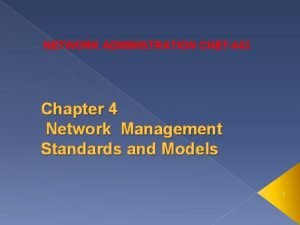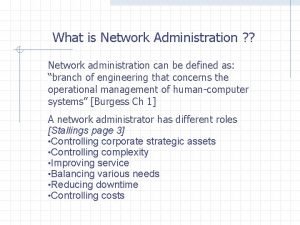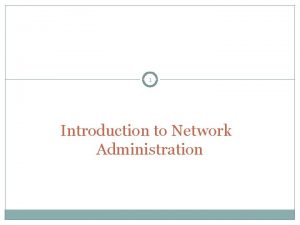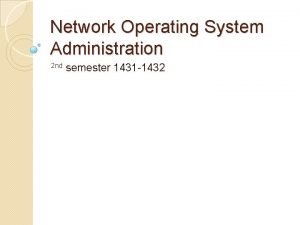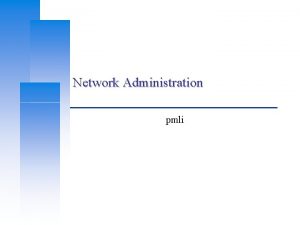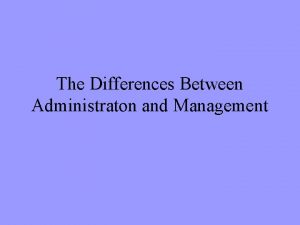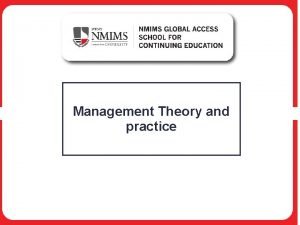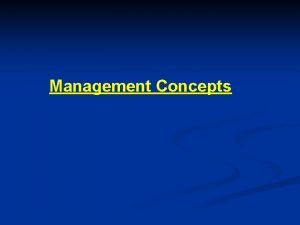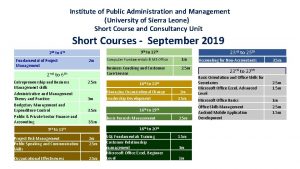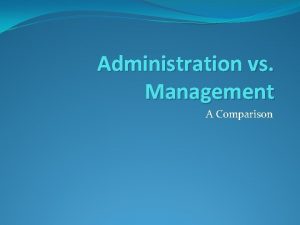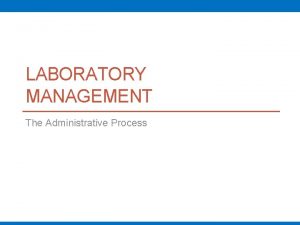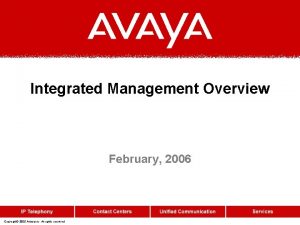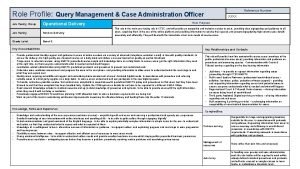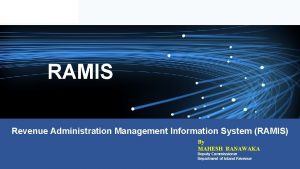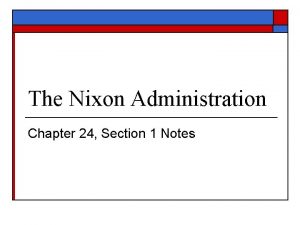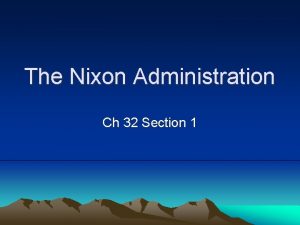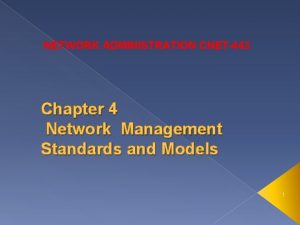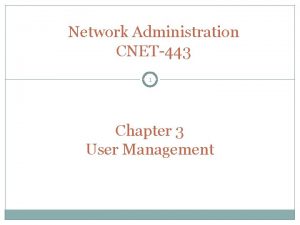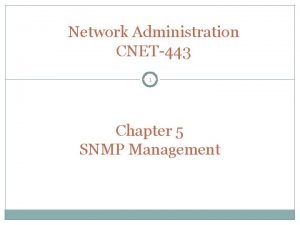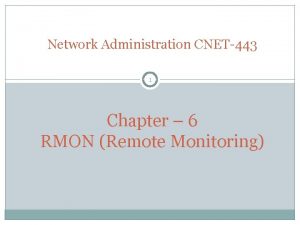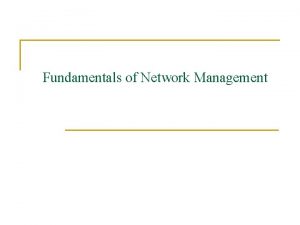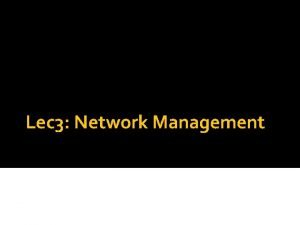NETWORK ADMINISTRATION CNET443 Chapter 4 Network Management Standards




















- Slides: 20

NETWORK ADMINISTRATION CNET-443 Chapter 4 Network Management Standards and Models 1

Chapter Outline 4. 1 NETWORK MANAGEMENT STANDARDS 4. 2 NETWORK MANAGEMENT MODELS 4. 3 SNMP MODEL 4. 4 ORGANIZATION MODEL 4. 5 SNMP COMMUNICATION MODEL 4. 5. 1 SNMP ARCHITECTURE 4. 5. 2 SNMP ADMINISTRATIVE MODEL 2

NETWORK MANAGEMENT STANDARDS The following are the network management standards in use: 1. OSI Management Protocol Standard 2. Internet Model 3. TMN Model 4. IEEE LAN/MAN Model These standards are discused in the following sections. 3

OSI Management Protocol Standard It is called Common Management Information Protocol (CMIP). The silent features of this standard are below. The OSI management protocol has built-in services, Common Management Information Service (CMIS). It is the most comprehensive set of specifications and addresses all seven layers. Management of data communications network—LAN and WAN. SNMP is the protocol that is extensively deployed. Object oriented Well structured and layered 4

OSI Management Protocol Standard Three models are designed for management applications to manage networks, systems, and services. 5

SNMP/Internet Standard The major positive points of Internet standard are, Industry standard (IETF) Originally intended for management of Internet components, currently adopted for WAN and telecommunication systems Easy to implement Most widely implemented 6

TMN Standard International standard (ITU-T) Management of telecommunications network Based on OSI network management framework Addresses both network and administrative aspects of management 7

IEEE Standard IEEE standards adopted internationally Addresses LAN and MAN management Adopts OSI standards significantly Deals with first two layers of OSI RM ( Reference model) 8

OSI Network Management Model The organization model describes the components of a network management system, their functions, and their infrastructure. It defines the terms object, agent, and manager. 2. The OSI information model deals with the structure and the organization of management information. It specifies the Structure of Management Information (SMI) and the information database, management information base (MIB). SMI describes how the management information is structured and MIB deals with the relationship and storage of management information. 1. 9

OSI Network Management Model 3. The communication model has these components. Ø Management application processes that function in the application layer, Ø layer management between layers Ø layer operation, which is within the layer 4. Functional Model: It deals with the user-oriented requirements of network management. There are five functional application areas defined in OSI, namely: Configuration, Fault, Performance, Security, Accounting. These are defined as system management functions in OSI. 10

organization model It describes the components of network management and their relationships. Network objects consist of network elements such as hosts, hubs, routers, etc. Objects can be classified into managed and unmanaged objects or elements. Two-Tier Network Management Organization Model Three-Tier Network Management Organization Model 11

Information Model An information model is concerned with the structure and storage of information. The representation of objects and information that are relevant to their management forms the management information model. The information model specifies the information base to describe managed objects and the relationship between managed objects. The structure defining the syntax and semantics of management information is specified by Structure of Management Information (SMI). 12

Management Information Base The information base is called the Management Information Base (MIB). The MIB is used by both agent and management processes to store and exchange management information. The manager MIB consists of information on all the network components that it manages. Manager has both the management database (MDB) and the MIB. The MDB is a real database. The MIB is a virtual database and contains the information necessary for processes to exchange information among themselves. 13

SNMP Communication Model This model is associated with how the information is exchanged between systems. Management data are communicated between agent and manager processes, as well as between manager processes. The applications in the manager module initiate requests to the agent in the Internet model. The agent executes the request on the network element; i. e. , managed object. 14

Management Communication Transfer Protocols 15

SNMP Architecture Model The SNMP architectural model consists of a collection of network management stations and network elements or objects. Network elements have management agents built in them. The SNMP communications protocol is used to communicate information between network management stations and management agents in the elements. SNMP monitors the network with the below mentioned five messages. SNMP Network Management Architecture 16

SNMP Administrative Model The SNMP administrative model defines the relationship among entities that participate in the communication protocol in SNMP have two types of entities, › Entities residing in management stations and network elements are called SNMP application entities. › Peer processes which are used to implement SNMP are called protocol entities. 17

SNMP Community The application entity residing in the management station as the SNMP manager. The application entity in the elements as the SNMP agent. The pairing of the two entities is called an SNMP community. The SNMP community name, called the community, is specified by a string of octets. SNMP Community 18

SNMP Community Profile A community profile in combination with the access mode of a managed object determines the operation that can be performed on the object by an agent. A pairing of an SNMP community with an SNMP community profile is defined as an SNMP access policy. SNMP Community Profile 19

Thanks 20
 Network management and administration
Network management and administration Factors necessary for service standards are
Factors necessary for service standards are Define network administration
Define network administration Introduction to network administration
Introduction to network administration Network operating system administration
Network operating system administration Network administration syllabus
Network administration syllabus Conclusion of management
Conclusion of management Difference between administration and management
Difference between administration and management According to kimball richman and copen administration is
According to kimball richman and copen administration is Administration definition in management
Administration definition in management Institute of public administration and management
Institute of public administration and management Administration vs management
Administration vs management Revenue administration management information system
Revenue administration management information system Project management in public administration
Project management in public administration Laboratory management and administration
Laboratory management and administration Avaya integrated management site administration
Avaya integrated management site administration Query management and case administration officer
Query management and case administration officer Revenue administration management information system
Revenue administration management information system Difference between management and administration ppt
Difference between management and administration ppt Chapter 24 section 1 the nixon administration
Chapter 24 section 1 the nixon administration Chapter 32 section 1 the nixon administration
Chapter 32 section 1 the nixon administration
